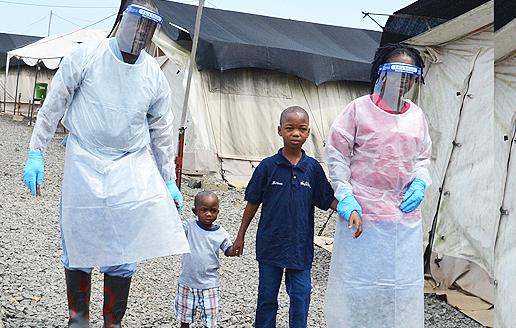
Who could possibly forget Ebola - the virus that we were all talking about before Zika? Although it sounded like something from a bad science fiction movie, it was all too real. Fortunately, it's gone. Or is it?
In June of this year, the WHO declared the end of Ebola virus transmission in the Republic of Guinea and in Liberia. This landmark came 42 days after the last person (the two year old boy in the photo) who was previously confirmed to have Ebola virus disease tested negative for the second time. Guinea and Liberia are currently in a 90-day period of heightened surveillance to ensure that any new cases are identified quickly before they can spread to other people.
But, that 90 day waiting period may be far too short, according to new data presented both at an Ebola-virus conference last week, and in a report published in the August 30 issue of Lancet Global Health.
The newest studies take advantage of a previously unavailable population - Ebola survivors. By studying people who survived Ebola in West Africa—there are tens of thousands of them—researchers were able to get a much better handle on the impact of the virus as a whole, with the ability to see trends and outliers in the population.
For example, by studying a population of 466 male Ebola survivors, the scientists identified 38 men who had Ebola virus remaining in their semen. Out of those 38, 24 of them tested positive for Ebola 12 months or longer after recovery. This is not good news.
Also, rare but meaningful cases were identified, such as the first case of a healthy mother who was experiencing no Ebola symptoms, yet passed the virus to her baby via breast milk. The baby later died from the infection.
The biggest cause for concern may be the transmission of virus by sperm. It is believed that the virus exists in sperm longer than other areas of the body because the testes do not have as strong of an immune system, allowing the virus to remain undetected longer. There are thousands of male Ebola survivors and many of them are participating in a study of Ebola viruses and semen being conducted through a collaboration between the CDC and the Liberian government.
At present, the longest that Ebola has been found to survive in sperm is 18 months following recovery. This is consistent with an outbreak that was attributed to a man 17 months after his recovery in Guinea and Liberia. It is certainly possible that the virus will be able to exist for longer than this, which highlights the importance of these new studies.
Another interesting finding regards a group of about 80 people in Guinea who had contact with Ebola patients and did not get sick. This alone is not too striking. Not everyone caught the disease. However, what is interesting is that a small subset of these people had an immune response to the Ebola virus, suggesting that they became infected, but remained asymptomatic.
There are two possible explanations at this time: 1) a small subset of people contracted a mild infection and did not have full blown symptoms 2) these people are naturally immune to Ebola. This second possibility is an interesting one and has been observed before, but not with Ebola.
There is a small subset of people in Africa that are immune to HIV because they have a mutation in the CCR5 receptor of T cells (the cells that HIV replicates in.) These "CCR5-Δ32" people have T cells that lack an essential component of the cell that normally enables HIV to enter the cell and then replicate. Despite high risk activities, they remain HIV negative. Perhaps these people that never experienced symptoms of Ebola have a similar mutation? And, if that is the case, they may be the key to understanding a target to stop Ebola infection.



